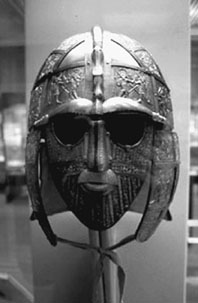

 | Page 1218 |  |
were not displayed until after World War II.

Anglo-Saxon helmet and mask from the Sutton Hoo burial site
(Image Select)
See also
Society of Antiquaries of London
References
Bruce-Mitford, Rupert L.S. 1975–1983. The Sutton Hoo Ship-Burial. London: British Museum Publications.
The Swahili towns on the East African coast have attracted the attention of scholars for many years. Colonial accounts of the origins of this widespread complex of sites, with visible architectural features comprising tombs, mosques, and palaces and substantial subsurface deposits, underplayed the indigenous contribution to the growth and development of the Swahili civilization. Recent archaeological and historical scholarship has gone some way toward reestablishing the urban identity of the peoples of the coast, and the Swahili are now recognized as centrally important in the western Indian Ocean system linking the Middle East, India, and the far interior of Africa.
The great majority of Swahili settlements and towns along the East African coast are found in a narrow coastal strip of sandy soils that support the Zanzibar-Inhambane vegetational mosaic (White 1983). In the northern zone, the Somali-Maasai mosaic provides a dry hinterland that is most suited to herding and hunting while to the south, the vast Zambezian forested areas provide resources for mixed agriculture and hunting and, of course, gold on the Zimbabwean plateau. The offshore island archipelago of the Comoros, which is partly volcanic, and northwestern madagascar, with its sheltered bays and richly forested interior, provide substantial opportunities for subsistence, trade, and urban development.
Hafun, near the Horn, which dates from the early centuries b.c. to about a.d. 200, is the earliest trading site yet located on the East African coast (Smith and Wright 1988)—quite possibly, it was one of the entrepôts mentioned in the Periplus of the Erythraean Sea (a document written ca. a.d. 50 in Greek and Egyptian, author unknown, describing contact with East Africa). Southward, the coastal zone is punctuated by a series of important rivers that provide access to the interior and often have trading sites at their mouths. The earliest town site in eastern Africa, that of Rhapta (known from the Periplus), has still not been located, but it was perhaps situated in the Rufiji delta where finds of early trade goods dated approximately 200 b.c.–a.d. 200 have been recently located by Felix Chami.
The existence of a town at that time might presuppose a settlement hierarchy of early farming community sites. Sites of the Kwale Matola tradition dating from the b.c.–a.d. transition to ca. a.d.400 are known to have existed in a great distributional swath along the coastal hinterland from Kenya down to southern Mozambique and into South Africa (Sinclair 1987; Soper 1971). The possibility that these early sites of iron-using farmers constituted a prestate settlement system
 |  |